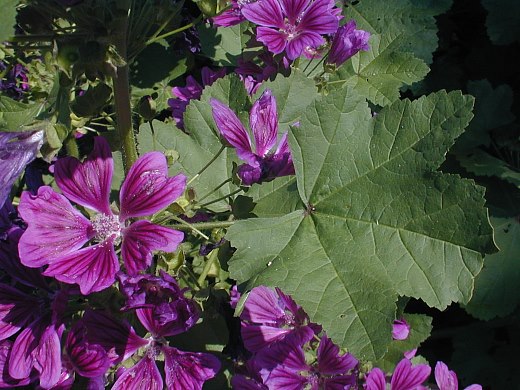Description: This plant is a biennial about 2–3½' tall that is either unbranched or sparingly so. The stout central stem is medium green, terete, and hairy. The alternate leaves are up to 5" long and 5" across; they are orbicular or reniform-orbicular in outline, divided into 5-7 shallow to moderate lobes, dentate along their margins, and palmately veined. For the typical variety of High Mallow, the lobes of the leaves are pointed, while for var. mauritiana they are rounded. The upper surfaces of the leaves are medium to dark green and mostly hairless. The petioles are up to 6" long.

The flowers occur
in clusters from the leaf axils along the upper half of each plant.
These flowers are about 2" across, consisting of 5 petals, a short
calyx with 5 ovate teeth, and a column of reproductive organs in the
center. The obcordate petals are reddish purple with dark purple veins.
The calyx is green and hairy; it is much shorter than the petals.
Directly underneath the calyx, there are 3 small bracts that are
lanceolate-ovate to ovate in shape. The styles emerge from the apex of
the reproductive column, while the stamens with white anthers develop
below. The pedicels of the flowers are up to 2" long. The blooming
period occurs from mid-summer to early fall and lasts about 2 months.
After the blooming period, each flower is replaced by a fruit called a
schizocarp in which the seed-containing carpels are arranged in a ring.
For High Mallow, there are about 10 carpels per
schizocarp. The carpels
are reniform and flattened in shape with exterior sides that are
reticulate and rough-textured; the carpels are hairless or only
slightly pubescent. This plant reproduces by reseeding itself.
Cultivation:
High Mallow adapts readily to partial or dappled sunlight, mesic
conditions, and a fertile loamy soil. It is not aggressive.
Range & Habitat:
This introduced plant has naturalized in widely scattered locations
throughout the state, although it rarely persists. Habitats include
such disturbed areas as roadsides, vacant lots, edges of yards, and
vacant lots. High Mallow was introduced from Europe as a horticultural
plant. It is still cultivated occasionally in gardens.
Faunal Associations:
Primarily bees cross-pollinate the flowers, where they seek nectar or
pollen. For High Mallow, Müller (1873/1883) observed such bee visitors
as honeybees, bumblebees, cuckoo bees, leaf-cutting bees, Andrenid
bees, and Halictid bees. Mallows (Malva spp.) are
food plants for the
caterpillars of Vanessa cardui (Painted Lady), Strymon
melinus (Gray Hairstreak), Pyrgus communis
(Checkered Skipper), and Anomis erosa (Yellow
Scallop Moth). Other insects that feed on mallows include Aphis
gossypii (Cotton Aphid), Anuraphis helichrysi
(Leafcurl Plum Aphid), and the major pest Popillia japonica
(Japanese Beetle).
Photographic Location:
A garden along a sidewalk in Urbana, Illinois.
Comments:
High Mallow is one of several Malva spp. that have
been introduced from Europe. Some of these are attractive horticultural
plants, while others are common weeds. High Mallow belongs to the
former. It can be distinguished from other mallows by its large
reddish-purple flowers (with obcordate petals) and shallowly to
moderately lobed leaves. Other large mallows in Illinois usually have
deeply divided leaves and white to rosy pink flowers. Another
introduced species, Alcea rosea (Hollyhock)
sometimes has similarly colored flowers, but it is a taller plant (up
to 6-8') with larger flowers (3" across or more) and the petals of its
flowers are more overlapping.